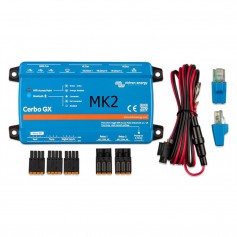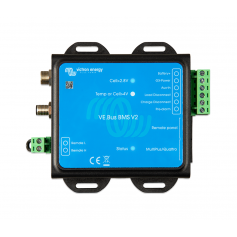Menu
Download
Data sheet
| Type | Rechargeable |
| Style | LiFePO4 |
| Manufacturing number | BAT512120610 |
| Target platform | LiFePO4 |
| Amperage | Does not apply |
| Voltage | 12.8V |
| Wattage | Does not apply |
| Capacity | 200Ah |
| Characteristics | Does not apply |
| Made in | Designed in The Netherlands. made in China |
| Trasporto speciale | SÌ |
More info
La batteria Victron Lithium LiFePO4 Smart si basa sulla tecnologia Litio Ferro Fosfato (LiFePO4 o LFP), la più sicura tra i tipi di batterie agli ioni di litio.
Le batterie Victron Smart LFP dispongono di bilanciamento e monitoraggio delle celle integrati. Ciò consente di leggere e monitorare le informazioni sulla tensione della cella e sulla temperatura della batteria con l'app Victron Connect Bluetooth. Queste informazioni vengono trasmesse attraverso due cavi a un sistema di gestione della batteria esterno per l'integrazione con altri componenti del sistema.
• Con bilanciamento delle celle integrato
• Può essere collegato in parallelo e in serie
• App Bluetooth disponibile per monitorare la tensione e la temperatura delle celle
Richiede uno di questi BMS:
• VE.Bus BMS – consigliato per sistemi con i nostri inverter/caricabatterie.
• smallBMS – consigliato per l'uso in sistemi di piccole dimensioni.
• Sistema di gestione della batteria BMS 12/200 – consigliato per l'uso in sistemi automobilistici e marini con carichi CC e alternatori.
• Smart BMS CL 12/100 – consigliato per l'uso in sistemi automobilistici e marini con carichi CC e alternatori.
• Lynx Smart BMS: consigliato per l'uso in sistemi di grandi dimensioni.
Perché il litio ferro fosfato?
Il litio ferro fosfato (LiFePO4 o LFP) è il più sicuro tra i principali tipi di batterie agli ioni di litio. La tensione nominale di una cella LFP è di 3,2 V (piombo-acido: 2 V/cella). Una batteria LFP da 12,8V è quindi composta da 4 celle collegate in serie; e una batteria da 25,6 V composta da 8 celle collegate in serie.
Robusto
Una batteria al piombo si guasterà prematuramente a causa della solfatazione:
• Quando si opera in modalità di scarsità per periodi prolungati (quando la batteria viene caricata raramente o mai completamente).
• Se immagazzinato parzialmente carico o, peggio, completamente scarico (in uno yacht o in una casa mobile durante l'inverno).
Una batteria LFP non ha bisogno di essere completamente caricata. La durata è anche leggermente più lunga caricando parzialmente la batteria invece che completamente. Questo è un grande vantaggio di LFP rispetto al piombo acido. Altri vantaggi includono un'ampia gamma di temperature di esercizio, eccellenti prestazioni del ciclo, bassa resistenza interna e alta efficienza (vedi sotto). LFP è quindi la scelta giusta per applicazioni molto impegnative.
Efficiente
L'efficienza energetica può essere essenziale in varie applicazioni (in particolare nell'energia solare e/o eolica autonoma). Il ciclo di efficienza energetica (scaricata dal 100% allo 0% e ricaricata al 100%) della batteria al piombo-acido media è dell'80%. Il ciclo di efficienza energetica di una batteria LFP è del 92%. Il processo di ricarica delle batterie al piombo-acido diventa particolarmente inefficiente quando lo stato di carica raggiunge l'80%, con conseguenti efficienze del 50% o anche meno nei sistemi solari che richiedono diversi giorni di riserva di carica (batteria che viene caricata dal 70% al 100% dello stato a titolo gratuito). lavori). Tuttavia, una batteria LFP ha ancora un'efficienza del 90% a scariche leggere.
Confronto con batterie al piombo
Le batterie LFP sono più costose rispetto alle batterie al piombo. Ma nelle applicazioni impegnative, l'elevato costo iniziale è più che compensato dalla maggiore durata, dall'affidabilità superiore e dall'eccezionale efficienza. Una batteria LFP consente di risparmiare fino al 70% di spazio ed è fino al 70% più leggera.
Bluetooth
Con il Bluetooth è possibile monitorare il voltaggio delle celle, la temperatura e lo stato degli allarmi. Molto utile per individuare (potenziali) problemi, come lo squilibrio cellulare.

 it
it
 de
de  en
en  es
es  fr
fr  nl
nl 



















 (NOME_PAESE).
(NOME_PAESE).















